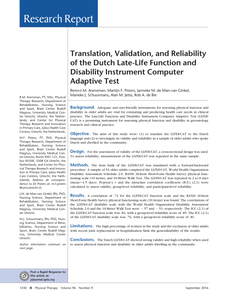De algemene gezondheidstoestand van de bevolking wordt veelal gemeten met de RAND-36 item Health Survey. De afkorting RAND verwijst naar de Amerikaanse onderzoeksorganisatie voor ‘Research and Development’ die de vragenlijst ontwikkelde. In 2012 is door Fontys en partners een longitudinaal veldonderzoek gestart met als doelstelling het in kaart brengen van factoren die van invloed zijn op het gebruik van technologie ter bevordering van het zelfstandig wonen door ouderen. In totaal worden 50 deelnemers van 70 jaar of ouder, vier jaar lang elke acht maanden geïnterviewd. Tevens worden er enkele vragenlijsten afgenomen waaronder twee vragen uit de RAND-36 waarvan een item luidt: ‘Ik ben net zo gezond als andere mensen die ik ken’. Tijdens dit onderzoek is gebleken dat sommige deelnemers die zichzelf gezonder vinden dan andere mensen die zij kennen, de stelling ontkennend beantwoorden maar daarmee onbedoeld een antwoordcategorie invullen die zich vertaalt in een lagere score voor de ervaren gezondheidstoestand. Het op deze manier invullen van dit item kan daardoor leiden tot een onderschatting van de algemene gezondheidstoestand van ouderen.
DOCUMENT
In order to overcome cancer-related problems and to improve quality of life, an intensive multi-focus rehabilitation programme for cancer patients was developed. We hypothesised that this six-week intensive rehabilitation programme would result in physiological improvements and improvement in quality of life. Thirty-four patients with cancer-related physical and psychosocial problems were the subjects of a prospective observational study. A six-week intensive multi-focus rehabilitation programme consisted of four components: individual exercise, sports, psycho-education, and information. Measurements (symptom-limited bicycle ergometry performance, muscle force and quality of life [RAND-36, RSCL, MFI]) were performed before (T0) and after six weeks of rehabilitation (T1). After the intensive rehabilitation programme, statistically significant improvements were found in symptom-limited bicycle ergometry performance, muscle force, and several domains of the RAND-36, RSCL and MFI. The six-week intensive multi-focus rehabilitation programme had immediate beneficial effects on physiological variables, on quality of life and on fatigue.
DOCUMENT

Background. Adequate and user-friendly instruments for assessing physical function and disability in older adults are vital for estimating and predicting health care needs in clinical practice. The Late-Life Function and Disability Instrument Computer Adaptive Test (LLFDICAT) is a promising instrument for assessing physical function and disability in gerontology research and clinical practice. Objective. The aims of this study were: (1) to translate the LLFDI-CAT to the Dutch language and (2) to investigate its validity and reliability in a sample of older adults who spoke Dutch and dwelled in the community. Design. For the assessment of validity of the LLFDI-CAT, a cross-sectional design was used. To assess reliability, measurement of the LLFDI-CAT was repeated in the same sample. Methods. The item bank of the LLFDI-CAT was translated with a forward-backward procedure. A sample of 54 older adults completed the LLFDI-CAT, World Health Organization Disability Assessment Schedule 2.0, RAND 36-Item Short-Form Health Survey physical functioning scale (10 items), and 10-Meter Walk Test. The LLFDI-CAT was repeated in 2 to 8 days (mean4.5 days). Pearson’s r and the intraclass correlation coefficient (ICC) (2,1) were calculated to assess validity, group-level reliability, and participant-level reliability. Results. A correlation of .74 for the LLFDI-CAT function scale and the RAND 36-Item Short-Form Health Survey physical functioning scale (10 items) was found. The correlations of the LLFDI-CAT disability scale with the World Health Organization Disability Assessment Schedule 2.0 and the 10-Meter Walk Test were .57 and .53, respectively. The ICC (2,1) of the LLFDI-CAT function scale was .84, with a group-level reliability score of .85. The ICC (2,1) of the LLFDI-CAT disability scale was .76, with a group-level reliability score of .81. Limitations. The high percentage of women in the study and the exclusion of older adults with recent joint replacement or hospitalization limit the generalizability of the results. Conclusions. The Dutch LLFDI-CAT showed strong validity and high reliability when used to assess physical function and disability in older adults dwelling in the community.
MULTIFILE
